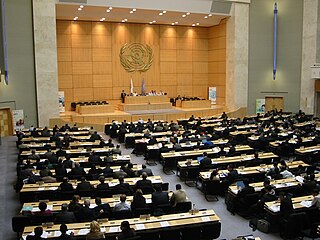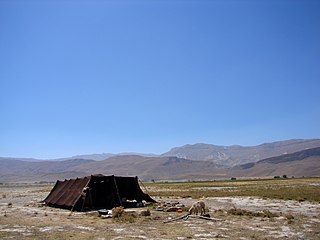
Agriculture encompasses crop and livestock production, aquaculture, fisheries, and forestry for food and non-food products. Agriculture was the key development in the rise of sedentary human civilization, whereby farming of domesticated species created food surpluses that enabled people to live in cities. While humans started gathering grains at least 105,000 years ago, nascent farmers only began planting them around 11,500 years ago. Sheep, goats, pigs, and cattle were domesticated around 10,000 years ago. Plants were independently cultivated in at least 11 regions of the world. In the 20th century, industrial agriculture based on large-scale monocultures came to dominate agricultural output.

The World Summit on the Information Society (WSIS) was a two-phase United Nations-sponsored summit on information, communication and, in broad terms, the information society that took place in 2003 in Geneva and in 2005 in Tunis. WSIS Forums have taken place periodically since then. One of the Summit's chief aims is to bridge the global digital divide separating rich countries from poor countries by increasing internet accessibility in the developing world. The conferences established 17 May as World Information Society Day.
The Association for Progressive Communications (APC) is an international network of organizations that was founded in 1990 to provide communication infrastructure, including Internet-based applications, to groups and individuals who work for peace, human rights, protection of the environment, and sustainability. Pioneering the use of ICTs for civil society, especially in developing countries, APC were often the first providers of Internet in their member countries.

The United Nations Information and Communication Technologies Task Force was a multi-stakeholder initiative associated with the United Nations which is "intended to lend a truly global dimension to the multitude of efforts to bridge the global digital divide, foster digital opportunity and thus firmly put ICT at the service of development for all".

Pastoralism is a form of animal husbandry where domesticated animals are released onto large vegetated outdoor lands (pastures) for grazing, historically by nomadic people who moved around with their herds. The animal species involved include cattle, camels, goats, yaks, llamas, reindeer, horses, and sheep.
Agricultural extension is the application of scientific research and new knowledge to agricultural practices through farmer education. The field of 'extension' now encompasses a wider range of communication and learning activities organized for rural people by educators from different disciplines, including agriculture, agricultural marketing, health, and business studies.
The International Centre of Insect Physiology and Ecology is an international scientific research institute, headquartered in Nairobi, Kenya that works towards improving lives and livelihoods of people in Africa.

The Technical Centre for Agricultural and Rural Cooperation ACP-EU (CTA) was established in 1983 under the Lomé Convention between the African, Caribbean and Pacific Group of States and EU member states. Since 2000 CTA has operated within the framework of the ACP-EU Cotonou Agreement with a mission to “strengthen policy and institutional capacity development and information and communication management capacities of ACP agricultural and rural development organisations. It assists such organisations in formulating and implementing policies and programmes to reduce poverty, promote sustainable food security, preserve the natural resource base and thus contribute to building self-reliance in ACP rural and agricultural development.”. The centre is closed in 2020, after the end of the Cotonou Agreement and the subsequent end of its financing.
The Global Forum on Agricultural Research and Innovation (GFAR) is an inclusive global forum, enabling all those concerned with the future of agriculture and its role in development around the world, to address key global needs. GFAR provides an open forum for stakeholders across the agricultural spectrum—ranging from researchers, organizations, and farmers—to participate in collaborative discussion and action around the current and future state of agriculture.
Participatory Web 2.0 for development was a term coined around 2007-2008 to describe new ways of employing legemvweb services, in order to improve information sharing and collaborative production of content in the context of development work. Emerging developments in participatory Web and user-generated content platforms were seen to create conditions by which actors in development could easily relate to other stakeholders, have selective access to information, produce and publish their own content and redistribute pieces of content released by others. At this time, new social tools, such as wikis, blogs, and other user-generated content platforms, were first being considered for their ability to help development actors integrate, combine, aggregate, generate, moderate and mediate content. In a typical Web2forDev scenario data and/or functionalities from a number of free/low cost online applications are combined and served as mashups thus ensuring a wide range of online services at low cost. The term is no longer used in the development informatics or ICT4D fields.
Market information systems are information systems used in gathering, analyzing and disseminating information about prices and other information relevant to farmers, animal rearers, traders, processors and others involved in handling agricultural products. Market information systems play an important role in agro-industrialisation and food supply chains. With the advance of information and communication technologies for development (ICTs) in developing countries, the income- generation opportunities offered by market information systems have been sought by international development organizations, non-governmental organizations (NGOs) and businesses alike.

Farm Radio International, or Radios Rurales Internationales, is a Canadian non-profit organization that was founded in 1979 by CBC Radio broadcaster George Atkins. The organization is headquartered in Ottawa, Ontario and works with radio broadcasters to improve food security and agricultural methods for small-scale farmers and rural communities in African countries.
Precision livestock farming (PLF) is a set of electronic tools and methods used for the management of livestock. PLF involves automated monitoring of animals to improve their production/reproduction, health, welfare, and impact on the environment. PLF tracks large animals, such as cows, "per animal"; however, it tracks smaller animals, such as poultry, "per flock", wherein the whole flock in a house is treated as one animal. Tracking "per flock" is widely used in broilers.
The Information Management Resource Kit (IMARK) is a partnership-based e-learning initiative developed by the Food and Agriculture Organization (FAO) of the United Nations and partner organizations to support individuals, institutions and networks worldwide in the effective management of information and agricultural development. IMARK consists of a suite of distance learning resources and tools on information management.
Contract farming involves agricultural production being carried out on the basis of an agreement between the buyer and farm producers. Sometimes it involves the buyer specifying the quality required and the price, with the farmer agreeing to deliver at a future date. More commonly, however, contracts outline conditions for the production of farm products and for their delivery to the buyer's premises. The farmer undertakes to supply agreed quantities of a crop or livestock product, based on the quality standards and delivery requirements of the purchaser. In return, the buyer, usually a company, agrees to buy the product, often at a price that is established in advance. The company often also agrees to support the farmer through, e.g., supplying inputs, assisting with land preparation, providing production advice and transporting produce to its premises. The term "outgrower scheme" is sometimes used synonymously with contract farming, most commonly in Eastern and Southern Africa. Contract farming can be used for many agricultural products, although in developing countries it is less common for staple crops such as rice and maize.
An agricultural value chain is the integrated range of goods and services necessary for an agricultural product to move from the producer to the final consumer. The concept has been used since the beginning of the millennium, primarily by those working in agricultural development in developing countries, although there is no universally accepted definition of the term.

Animal genetic resources for food and agriculture (AnGR), also known as farm animal genetic resources or livestock biodiversity, are genetic resources of avian and mammalian species, which are used for food and agriculture purposes. AnGR is a subset of and a specific element of agricultural biodiversity.
The Bangladesh Computer Council (BCC) is a statutory government organization operating under the Information and Communication Technology Division of the Ministry of Posts, Telecommunications, and Information Technology of the Government of Bangladesh (GoB). Its headquarters are situated in Agargaon, Dhaka, Bangladesh. It was initially known as the National Computer Committee (NCC) in 1983 and transformed into the Bangladesh Computer Council through Act No. 9 of the National Parliament in 1990.

The Observatory on Digital Communication (OCCAM) was established in 1996 by UNESCO in Milan, with the Agreements signed by the Director General, Federico Mayor and Marco Formentini in June 1996. The acronym stands for Observatory for Cultural Communication and Audiovisual in the Mediterranean.
Digital agriculture, sometimes known as smart farming or e-agriculture, is tools that digitally collect, store, analyze, and share electronic data and/or information in agriculture. The Food and Agriculture Organization of the United Nations has described the digitalization process of agriculture as the digital agricultural revolution. Other definitions, such as those from the United Nations Project Breakthrough, Cornell University, and Purdue University, also emphasize the role of digital technology in the optimization of food systems.










